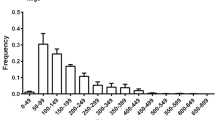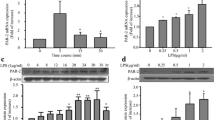Abstract
Platelet-activating factor (PAF) stimulates leukocyte-endothelial cell (EC) adhesion through its effects either on leukocytes or on ECs. ECs may be injured, synthesize, or express new adhesive proteins to increase leukocyte adhesion. Intermediary mediators produced by activated ECs are also likely involved in promoting leukocyte adhesion. Our experiments demonstrated that PAF induced no obvious damage to bovine pulmonary artery ECs evaluated by lactic dehydrogenase release rate, angiotensin-converiting enzyme activity, and cellular malondialdehyde content. Treatment of EC morolayers with 10−9 M PAF increased polymorphonuclear leukocyte (PMN) adhesion. Increasing PAF concentration did not induce more PMN adherence. PAF elicited both a rapid and prolonged increment of PMN adherence to EC monolayers. The rapid adherence was greatly attenuated by pretreatment of ECs with PAF receptor antagonist SRI 63-441 but was not affected by pretreatment of PMNs with SRI 63-441, suggesting that PAF increases PMN adherence rapidly through its effects on specific receptors on ECs. Increased PMN adherence lasted if PAF treatment of ECs was sustained for 3 or 6 h. Pretreatment of ECs with actinomycin D, a protein synthesis inhibitor, significantly decreased PAF-induced sustained PMN adherence, but the inhibition is incomplete, suggesting that other mechanisms than protein synthesis also participated in the prolonged PMN adherence. We concluded from the results that PAF may induce both rapid and prolonged PMN adhesion to ECs. The effects are receptor mediated. The prolonged PMN adhesion is partly the result of protein synthesis.
Similar content being viewed by others
References
Braquet, P., L. Touqui, T. Y. Shen, B. B. Vargaftig. 1987. Perspectives in platelet-activating factor research.Pharmacol. Rev. 39:97–145.
Shaw, J. O., R. N. Pinckard, K. S. Ferrigni, L. M. McManus, andD. J. Hanahan. 1981. Activation of human neutrophils with l-o-hexadecyl/octodecyl-2-acetyl-sn-glyceryl-3-phosphorylcholine (platelet-activating factor).J. Immunol. 127:1250–1255.
Tonnesen, M. G., D. C. Anderson, T. A. Springer, A. Knedler, N. Avdi, andP. M. Henson. 1989. Adherence of neutrophils to cultured human microvascular endothelial cells. Stimulation by chemotactic peptides and lipid mediators and dependence upon the Mac-1, LFA-1, p150,95 glycoprotein family.J. Clin. Invest. 83:637–646.
Bussolino, F., G. Camusi, M. Aglietta, P. Braquet, A. Bosia, G. Pescarmona, F. San-Avio, N. D'urso, andP. C. Marchisio. 1987. Human endothelial cells are target for platelet-activating factor. I. Platelet-activating factor induces changes in cytoskeleton structures.J. Immumol. 139:2439–2446.
Burhop, K. E., J. G. N. Garcia, W. M. Selig, S. K. Lo, H. Zee, J. E. Kaplan, andA. B. Malik. 1986. Platelet-activating factor increases lung vascular permeability to protein.J. Appl. Physiol. 61:2210–2217.
Garcia, J. G. N., A. Azghani, K. S. Callahan, andA. R. Johnson. 1988. Effect of platelet-activating factor on leukocyte-endothelial cell interactions.Thromb. Res. 51:83–96.
Ryan, U. S., E. Clements, D. Habliston, andJ. W. Ryan. 1978. Isolation and culture of pulmonary artery endothelial cells.Tissue Cell 10:535–554.
Li, S. H., andZ. L. Wu. 1986. Microspectrophotometric determination of angiotensin converting enzyme in serum.Acad. J. SMMU 7:437–440.
Ohkawa, H., N. Ohishi, andK. Yagi. 1979. Assay for lipid peroxides in animal tissues by thiobarbituric acid reaction.Anal. Biochem. 95:351–358.
Zimmerman, G. A., T. M. McIntyre, andS. M. Prescott. 1985. Thrombin stimulates the adherence of neutrophils to human endothelial cells in vitro.J. Clin. Invest. 76:2235–2246.
Kubes, P., M. Suzuki, andD. N. Granger. 1990. Platelet-activating factor induced micro-vascular dysfunction: Role of adherent leukocytes.Am. J. Physiol. 258:G158-G163.
Kubes, P., G. Ibbotson, J. Russell, J. L. Wallace, andD. N. Granger. 1990. Role of platelet-activating factor in ischemia/reperfusion induced leukocyte adherence.Am. J. Physiol. 259:G300-G305.
Dillon, P. K., M. F. Fitzpatrick, A. B. Ritter, andW. N. Duran. 1988. Effects of platelet-activating factor on leukocyte adhesion to microvascular endothelium. Time course and dose-response relationships.Inflammation 12:563–573.
Zimmerman, G. A., T. M. McIntyre, M. Mehra, andS. M. Prescott. 1990. Endothelial cell-associated platelet-activating factor: A novel mechanism for signaling intercellular adhesion.J. Cell. Biol. 110:529–540.
McIntyre, T. M., G. A. Zimmerman, andS. M. Prescott. 1986. Leukotrienes C4 and D4 stimulate human endothelial cells to synthesize platelet activating factor and bind neutrophils.Proc. Natl. Acad. Sci. U.S.A. 83:1557–1562.
Lewis, M. S., R. E. Whatley, P. Cain, T. M. McIntyre, S. M. Prescott, andG. A. Zimmerman. 1988. Hydrogen peroxide stimulates the synthesis of platelet-activating factor by endothelium and induces endothelial cell-dependent neutrophil adhesion.J. Clin. Invest. 82:2045–2055.
Toothill, V. J., J. A. Van Mourik, H. K. Niewenhuis, M. J. Metzelaar, andJ. D. Pearson. 1990. Characterization of the enhanced adhesion of neutrophil leukocytes to thrombin-stimulated endothelial cells.J. Immunol. 145:283–291.
Zimmerman, G. A., andT. M. McIntyre. 1988. Neutrophil adherence to human endothelium in vitro occurs by CDw18 (Mol, MAC-1/LFA-1/GP150,95) glycoprotein-dependent and independent mechanisms.J. Clin. Invest. 81:531–537.
Hattori, R., K. K. Hamilton, andR. D. Fugate. 1989. Stimulated secretion of endothelial von Willebrand factor is accompanied by rapid redistribution to the cell surface of the intra-cellular granule membrane protein GMP-140.J. Biol. Chem. 264:7768–7771.
Schwartz, B. R., andJ. M. Harlan. 1988. Mechanism of granulocyte-endothelial cell adhesion.In Endothelial Cells, Vol II. U. S. Ryan, editor. CRC Press, Boca Raton, Florida.
Cotran, R. S. 1987. New roles for the endothelium in inflammation and immunity.Am. J. Pathol. 129:407–413.
Author information
Authors and Affiliations
Rights and permissions
About this article
Cite this article
Ding, Z., Li, S. & Wu, Z. Mechanisms of endothelial cell-dependent leukocyte adhesion stimulated by platelet-activating factor. Inflammation 16, 179–186 (1992). https://doi.org/10.1007/BF00918957
Issue Date:
DOI: https://doi.org/10.1007/BF00918957




